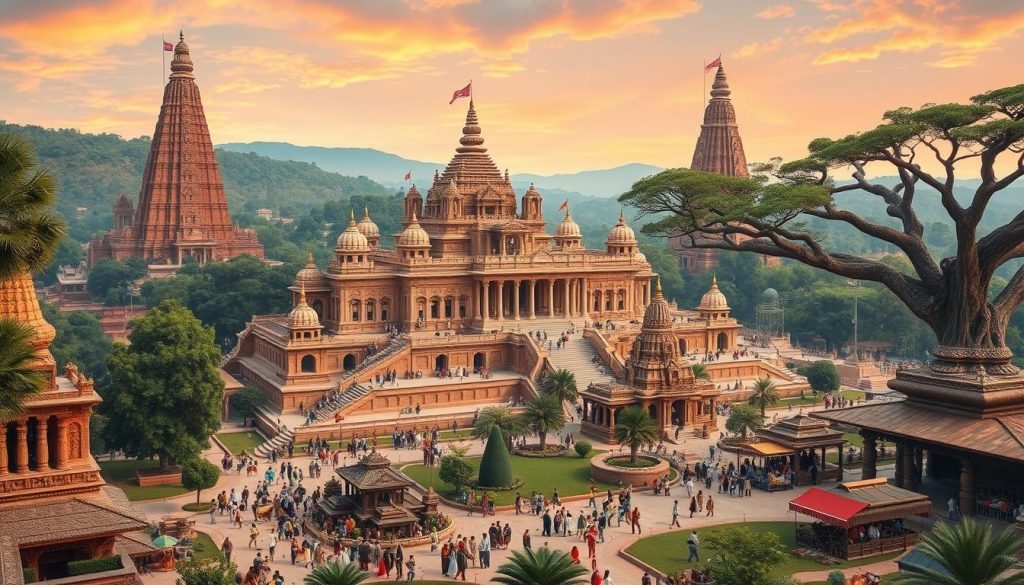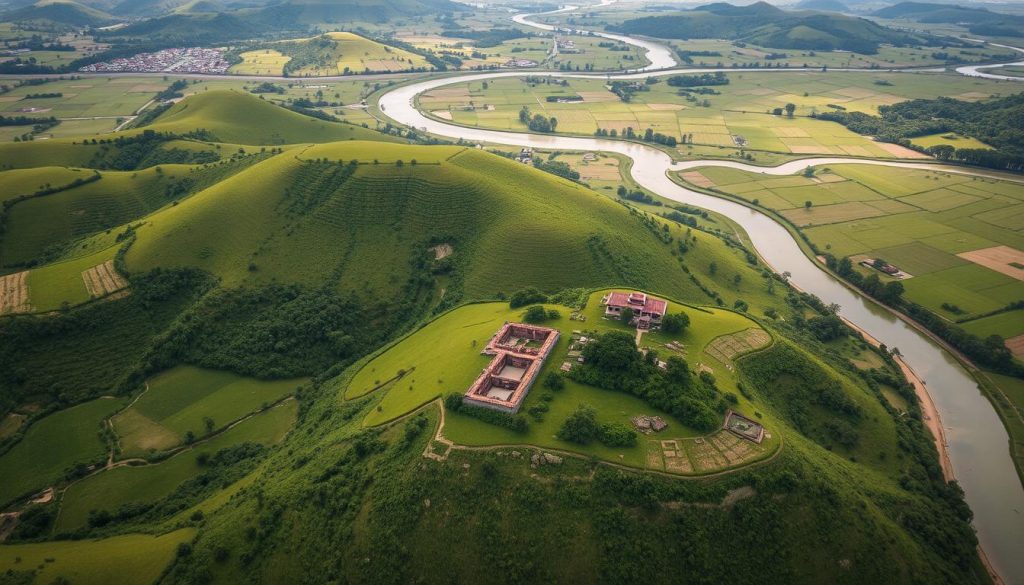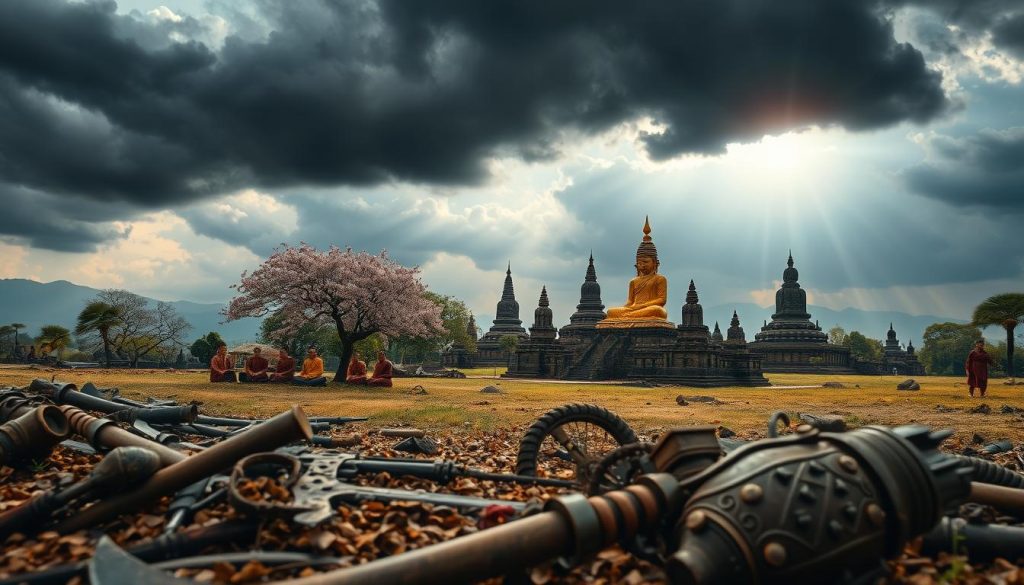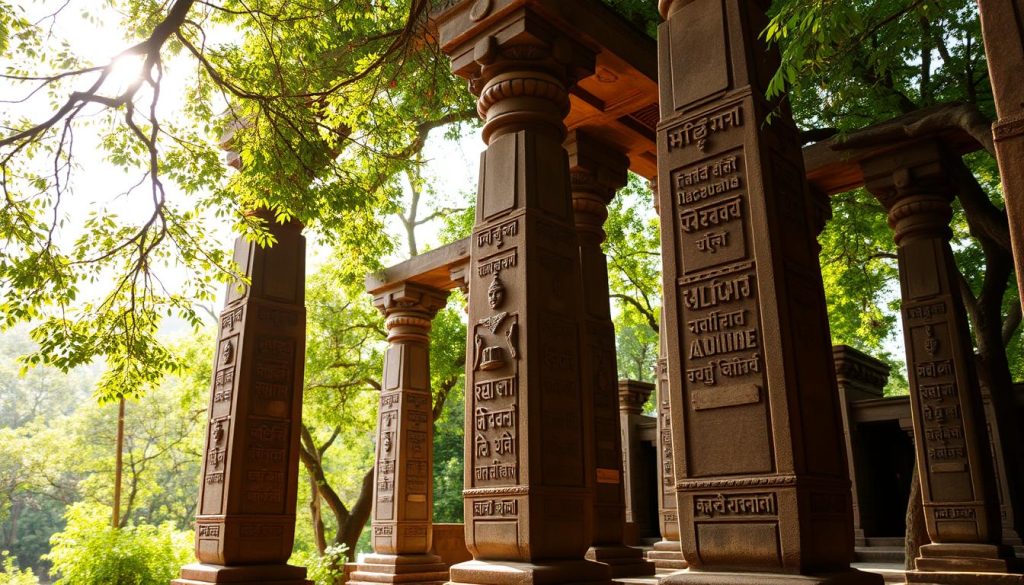Kalinga War Impact the Mauryan Empire and Emperor Ashoka
In ancient Indian history, a key moment changed an empire and a ruler’s legacy. The Kalinga War was between the Mauryan Empire and Kalinga. It was a story of great bloodshed, change, and the start of Buddhism.
This event changed ancient India’s politics and left a mark on Emperor Ashoka. His reign was changed by the horrors he saw in the war.

Key Takeaways
- The Kalinga War was a decisive military conflict between the Mauryan Empire and the independent kingdom of Kalinga.
- The brutality and scale of the war profoundly impacted Emperor Ashoka, leading to his spiritual awakening and conversion to Buddhism.
- Ashoka’s post-war policies of non-violence, social reforms, and the spread of Buddhist teachings across Asia transformed the Mauryan Empire.
- The Edicts of Ashoka, including the major rock edicts and pillar inscriptions, stand as enduring testaments to the emperor’s commitment to peace and dharma.
- The legacy of the Kalinga War continues to shape Indian history, culture, and philosophy, with its lessons on the futility of violence and the power of compassion.
Historical Background of the Mauryan Empire Before Kalinga War
The Mauryan Empire was a huge and influential empire in ancient India. It had a rich history that led to the Kalinga War. This part talks about the rise of the Mauryan dynasty, Ashoka’s early years, and the politics of that time. It helps us understand the Kalinga War’s impact on Indian history.
Rise of the Mauryan Dynasty
The Mauryan Empire started with Chandragupta Maurya, a great military leader. He united the Indian subcontinent in the 4th century BCE. His work laid the groundwork for the empire’s growth and expansion.
Ashoka’s Early Reign and Military Campaigns
Emperor Ashoka, Chandragupta’s grandson, made the Mauryan Empire even stronger. He took over in the 3rd century BCE and expanded the empire through wars. But, the conquest of Kalinga changed him and his legacy forever.
Political Landscape of Ancient India
- The Mauryan Empire was in a complex political world. Many regional kingdoms and rivals fought for control.
- This complex situation offered both challenges and chances for the Mauryans to grow their power.
- Managing alliances, conflicts, and power struggles was key for the Mauryans during this time.
This background prepares us for the Kalinga War. It shows how the Mauryan Empire and Emperor Ashoka were affected by it.

The Strategic Importance of Kalinga Region
The Kalinga region was key for the Mauryan Empire during the Kalinga War. It was rich in natural resources and had a strong trade network. These factors made it a prime target for the Mauryans.
Kalinga’s coastal spot gave the Mauryans a gateway to the Indian Ocean and Southeast Asia. This spot was perfect for trade, boosting the local economy and making Kalinga very valuable to the Mauryans.
| Key Resources of Kalinga | Significance for the Mauryan Empire |
|---|---|
| Mineral Deposits | Kalinga was rich in minerals like iron, copper, and diamonds. These were crucial for the Mauryan military and building projects. |
| Agricultural Productivity | The fertile lands of Kalinga gave the Mauryans a steady food supply. This was important for their growing population. |
| Timber and Shipbuilding | The forests in Kalinga provided the Mauryans with the wood needed for their ships. This helped them control the sea trade routes. |
Conquering Kalinga would have given the Mauryans more control over the coast. This would have helped them grow their power and stay the top force in ancient India. Ashoka saw Kalinga’s importance and launched the Kalinga War to claim it.

“The Kalinga region was a vital component of the Mauryan Empire’s expansionist ambitions, as its strategic location and abundant resources made it a coveted prize for the ruling dynasty.”
The Battle That Changed History: Kalinga War Overview
The Kalinga War was a key moment in the Mauryan Empire’s history. It happened during Emperor Ashoka‘s reign. This battle changed Indian history forever.
Military Tactics and Warfare Strategies
The Kalinga War showed the Mauryan military’s strength and strategy. Ashoka’s generals used many tactics, like troop movements and war elephants. This clash was a mix of power and smart planning.
Scale of the Conflict
The conquest of Kalinga was huge. The Mauryans had thousands of soldiers, archers, and elephants. The war’s size had a big impact on the region and the empire.
Casualties and Aftermath
The Kalinga War was very bloody. Over 100,000 Kalinga soldiers died, and many were hurt or taken prisoner. The war’s violence deeply affected Emperor Ashoka.
“The Kalinga War, with its immense destruction and loss of life, marked a turning point in Ashoka’s reign, leading him to renounce violence and embrace the principles of Buddhism.”
The war’s effects were felt across the Mauryan Empire. It led to Ashoka’s change and his Dhamma, a policy of peace and tolerance.
Kalinga War Impact the Mauryan Empire and Emperor Ashoka
The Kalinga War had a huge impact on the Mauryan Empire and Emperor Ashoka. The war’s scale and destruction changed ancient India’s politics and society.
The Mauryan Empire, under Ashoka, had grown across much of India. But the Kalinga War tested Ashoka’s military and empire’s stability. The war’s violence made Ashoka doubt conquest and violence.
After the Kalinga War, Ashoka changed a lot. Seeing the war’s horrors made him rethink war and expansion. This change started his spiritual journey and his move to Buddhism.
| Impact of the Kalinga War | Mauryan Empire | Emperor Ashoka |
|---|---|---|
| Scale of the Conflict | Significant challenge to the empire’s stability | Witnessed the devastating consequences of war |
| Casualties and Aftermath | Questioned the merits of conquest and violence | Began to question the value of military might |
| Shift in Imperial Policy | Embraced a new approach of non-violence and peace | Embarked on a spiritual transformation and Buddhist conversion |
The Kalinga War was a key moment in the Mauryan Empire and Ashoka’s life. It led to Ashoka’s Buddhist teachings and non-violent policies. These changes had a big impact on the region and the Mauryan Dynasty’s legacy.
Ashoka’s Transformation and Buddhist Conversion
The Kalinga War had a huge impact on Emperor Ashoka. It was a turning point in his life and in the Mauryan Empire’s history. After seeing the bloodshed and destruction, Ashoka had a deep spiritual awakening. This changed how he ruled and treated his people.
Spiritual Awakening
The Kalinga War deeply troubled Ashoka. He was shaken by the loss of life and the suffering of the people. This experience made him give up violence and embrace non-violence and compassion.
Influence of Buddhist Philosophy
Buddhism’s teachings deeply influenced Ashoka during this time. The ideas of ahimsa (non-violence), dharma (righteousness), and karuna (compassion) really spoke to him. They inspired him to rule with kindness and justice.
Personal and Political Changes
Ashoka’s conversion to Buddhism changed him deeply. He stopped his military plans and focused on his people’s well-being. He introduced reforms to promote peace and non-violence, reflecting his new beliefs.
Implementation of Dhamma and New Administrative Policies
After the Kalinga War, Emperor Ashoka wanted to change the Mauryan Empire deeply. He focused on dhamma, a belief in doing right, being kind, and not hurting others.
Ashoka made dhamma the base of his new rules. He created dhamma-mahamattas, or religious officers. Their job was to spread non-violence and help people all over the empire.
- Ashoka’s dhamma taught living right, not hurting others, and being open to all religions.
- He also made dhamma-yatras, royal visits, to talk to his people and listen to their needs.
- Ashoka worked on building roads, places to rest, and hospitals. He wanted to make life better for everyone in the Mauryan Empire.
With these big changes, Emperor Ashoka aimed to build a peaceful and happy society. He wanted a place where everyone followed dhamma and lived in peace and understanding.
| Administrative Policy | Description |
|---|---|
| Dhamma-mahamattas | Network of religious officers responsible for disseminating the principles of non-violence and social welfare |
| Dhamma-yatras | Regular royal visits to stay connected with the people and address their concerns |
| Infrastructure Development | Construction of roads, rest houses, and hospitals to improve the overall quality of life |
“My only conquest is the conquest of dhamma (righteousness).” – Emperor Ashoka
The Edicts of Ashoka: Spreading Peace and Non-violence
Emperor Ashoka’s rule was a turning point for the Mauryan Empire. He adopted Buddhism and aimed to spread peace and non-violence. The Edicts of Ashoka show his vision for his people and the wider area.
Major Rock Edicts
The rock edicts of Ashoka are carved into huge rocks across the empire. They express his dedication to dhamma, or right living. These edicts talk about religious freedom, social care, and the need to avoid violence.
Pillar Edicts and Their Significance
Ashoka’s pillar edicts are tall monuments to his ideals. Written in Brahmi script, they explain dhamma and how to run the empire fairly. They show Ashoka’s goal for a fair and peaceful society.
Brahmi Inscriptions across the Empire
Ashoka’s message of peace was shared through Brahmi inscriptions everywhere. These inscriptions were on walls and stones. They show how far Ashoka’s message of dhamma reached.
| Type of Edict | Geographical Spread | Key Themes |
|---|---|---|
| Rock Edicts | Across the Mauryan Empire, including present-day Afghanistan, Pakistan, and India | Religious tolerance, social welfare, condemnation of violence, ethical governance |
| Pillar Edicts | Primarily in northern India, with a few located in Nepal and Pakistan | Principles of dhamma, instructions for imperial administration |
| Brahmi Inscriptions | Widespread throughout the Mauryan Empire, found on various surfaces | Dissemination of Ashoka’s message of peace and non-violence |
The Edicts of Ashoka are a strong proof of Ashoka’s change and his aim for a peaceful society. Through these writings, Ashoka’s dream of peace and non-violence lives on in Indian history.
Cultural and Social Reforms Following the War
After the Kalinga War, Emperor Ashoka of the Mauryan Empire changed deeply. He was deeply moved by the bloodshed and suffering. Ashoka then turned away from violence and embraced Buddhism, changing his empire’s culture and society.
Ashoka’s new commitment to peace and kindness led to big changes. He spread Buddhist teachings, building monasteries, universities, and learning centers. This focus on education and spiritual growth greatly influenced the Mauryan Empire’s culture.
In art and architecture, Ashoka’s support led to amazing creations. The famous Ashoka Pillars and stunning Stupa monuments were built. These works showed the empire’s cultural strength and its new values of non-violence and Buddhist conversion.
Ashoka also worked to make society fairer and more just. He improved how prisoners were treated, helped the elderly and disabled, and ensured justice was served. These actions showed Emperor Ashoka‘s dedication to Buddhist conversion and improving his people’s lives.
The changes Ashoka made after the Kalinga War had a lasting impact on the Mauryan Empire. By following Buddhism and promoting peace, he ushered in a time of growth, cultural richness, and a legacy that still inspires today.
| Cultural Reforms | Social Reforms |
|---|---|
| Promotion of Buddhist philosophy and monasteries Establishment of universities and centers of learning Patronage of art and architecture, including Ashoka Pillars and Stupas | Reforms addressing prisoner welfare Measures for the care of the elderly and disabled Initiatives for fair administration of justice |
Legacy of the Kalinga War in Indian History
The Kalinga War, during Emperor Ashoka’s time in the Mauryan Empire, changed Indian history deeply. This war shaped ancient India’s politics and society. It also changed Ashoka, leading him to follow Buddhism and its values of peace and kindness.
Impact on Future Generations
The Kalinga War’s effects lasted for centuries, influencing Indian civilization. Ashoka’s change from a harsh ruler to one who valued peace and justice was a big lesson for others. His messages of peace and justice, shared through rock and pillar edicts, inspired many leaders and thinkers.
Modern Interpretations and Relevance
Today, the Kalinga War and Ashoka’s change are key topics in studying Indian history and leadership. Scholars look at the war’s impact on power, violence, and creating a fair society. They learn about the complex links between these ideas.
Ashoka’s ideas on tolerance, saving lives, and helping others are still important today. They talk about peace, solving conflicts, and living sustainably. The Kalinga War shows how compassion can change even the strongest leaders for the better.
| Key Aspects | Impact |
|---|---|
| Strategic Importance | The Kalinga region’s control was vital for the Mauryan Empire’s expansion and dominance in the Indian subcontinent. |
| Ashoka’s Transformation | The horrors of the Kalinga War led Ashoka to renounce violence and embrace the principles of Buddhism, becoming a champion of peace and non-violence. |
| Lasting Legacy | Ashoka’s edicts and policies influenced subsequent rulers and thinkers, shaping the cultural, social, and political landscape of India for centuries to come. |
The Kalinga War and its effects are a key part of Indian history. They show the power of change, the impact of leadership, and the lasting value of peace, kindness, and fairness.
Conclusion
The Kalinga War was a turning point in the Mauryan Empire and Emperor Ashoka’s rule. It changed the political scene of ancient India. It also made Ashoka change his ways and believe in Buddhist non-violence and kindness.
After the war, Ashoka started many changes in the empire. He wanted peace and good behavior everywhere. He built many rock and pillar edicts to share his message of peace and tolerance.
The Kalinga War was a key event in Indian history. It changed the Mauryan Empire and the region’s beliefs and society. Ashoka’s change from a fierce warrior to a supporter of peace shows us how much one person can change. The Kalinga War’s legacy still affects us today.
FAQ
What was the Kalinga War, and how did it impact the Mauryan Empire?
The Kalinga War was a major conflict in the 3rd century BCE. It was between the Mauryan Empire and Kalinga (modern-day Odisha). Emperor Ashoka’s victory led to a huge loss of life and changed him deeply.
This event made Ashoka turn away from war. He started following Buddhism, changing his empire’s ways. He spread the dharma, or right teachings, far and wide.
What was the significance of the Kalinga region for the Mauryan Empire?
Kalinga was key for the Mauryan Empire. It was rich in resources and controlled important trade routes. Taking Kalinga would have made the empire stronger and more united.
How did the Kalinga War transform Emperor Ashoka’s worldview?
The Kalinga War changed Ashoka deeply. Seeing so much suffering made him wake up spiritually. He then gave up violence and followed Buddhism.
Buddhism taught him about kindness and helping others. This new view guided his rule. He worked on reforms, spread the dharma, and promoted peace.
What were the key policies and reforms implemented by Emperor Ashoka after the Kalinga War?
After the war, Ashoka made big changes. He started a new way of ruling based on dhamma. This was a mix of ethics and good governance.
He also allowed different religions and stopped harmful practices. He built hospitals, roads, and irrigation systems. His Edicts were messages of peace and the dharma.
How did Ashoka’s Edicts contribute to the dissemination of Buddhist teachings?
Ashoka’s Edicts helped spread Buddhism far and wide. They were carved on rocks and pillars across the empire. This way, his message of kindness and tolerance reached many.
The Edicts talked about justice, dhamma, and caring for all. They changed the culture and society of the Mauryan Empire and beyond.
What was the long-term legacy of the Kalinga War and Ashoka’s transformation?
The Kalinga War and Ashoka’s change had a big impact. It led to a more peaceful India. His teachings of kindness and welfare inspired many.
The Edicts of Ashoka and Buddhism spread far. This changed the culture and philosophy of the region. The Kalinga War marked a shift to a more caring empire.







